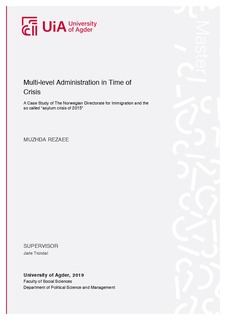| dc.contributor.author | Rezaee, Muzhda | |
| dc.date.accessioned | 2019-10-08T10:01:09Z | |
| dc.date.available | 2019-10-08T10:01:09Z | |
| dc.date.issued | 2019 | |
| dc.identifier.uri | http://hdl.handle.net/11250/2620836 | |
| dc.description | Master's thesis Public Policy and Management ME502 - University of Agder 2019 | nb_NO |
| dc.description.abstract | In Autumn 2015, a record high number of 31,145 asylum seekers entered Norway. The overflow of refugees caused an organizational challenge for the national agency, the Norwegian Directorate for immigration (UDI). The challenge was expected for an organization like the UDI which operates within a Multi-level administration system (MLA), both under Norwegian state and within the European. The overflow of the refugees is consideredas a crisis, calling for cooperation and coordination of the affected and relevant entities and units both within and across organizations. Beside revealing the UDI’s inability and lack of resources and capacity to handle the uncommon situation, the crisis also revealed the weak coordination among affected and relevant entities and units across the levels of government. The goal of this thesis is to understand the organizational response to the refugee crisis through a theoretical perspective: MLA. This is particularly a study of MLA. The UDI as the national agency is a case for this study. This thesis mainly studies the coordination proximity of the UDI with other actors both at the national and international level in time of crisis, in order to examine how and to what extent the UDI was in coordination with the Ministry of Justice and Public Security (JD), European Commission (EC) and sister agencies in other countries. It is also a study of the coordination pattern within the UDI. The study illustrates by the asylum crisis of 2015 and investigates how didthe UDI addressed the peak of the so-called asylum crisis of 2015 both internally and externally. The purpose of the thesis is to understand UDI’s administrative actual behaviour during crisis from an organizational perspective. The thesis finds support for the organizational perspective pointing out that national agencies form part of an integrated administration. Specialization principles in the national state and at EU level enable the UDI’s extensive contact with the EC, the EU agency -European AsylumSupport Office (EASO) and sister agencies in other countries related to immigration and asylum matters. National agencies’ representatives are also concerned with having professional discussions and information exchange at EU level. The proximity of the coordination with actors at the national level and specially with the JD, to which the UDI is a subordinate body, is stronger than other actors during the crisis. | nb_NO |
| dc.language.iso | eng | nb_NO |
| dc.publisher | Universitetet i Agder ; University of Agder | nb_NO |
| dc.rights | Attribution-NonCommercial-NoDerivatives 4.0 Internasjonal | * |
| dc.rights.uri | http://creativecommons.org/licenses/by-nc-nd/4.0/deed.no | * |
| dc.subject | ME502 | nb_NO |
| dc.title | Multi-level Administration in Time of Crisis : A Case Study of The Norwegian Directorate for Immigration and the so called “asylum crisis of 2015" | nb_NO |
| dc.type | Master thesis | nb_NO |
| dc.subject.nsi | VDP::Samfunnsvitenskap: 200::Statsvitenskap og organisasjonsteori: 240::Offentlig og privat administrasjon: 242 | nb_NO |
| dc.source.pagenumber | 85 p. | nb_NO |

